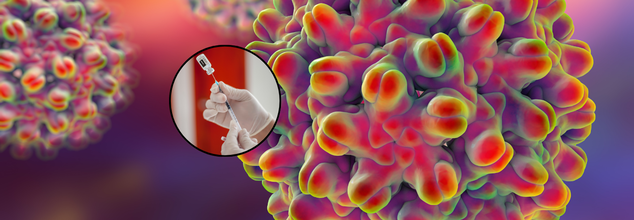- Health Conditions A-Z
- Health & Wellness
- Nutrition
- Fitness
- Health News
- Ayurveda
- Videos
- Medicine A-Z
- Parenting
- Web Stories
Does A Better Alternative to Covid-19 Vaccine Exist? Here's What You Need To Know

Credits: Canva
The world is again gearing up as COVID-19 returns in many Asian cities, including Hong Kong, Singapore, and Thailand. Cases have also been reported in India. If experts are to be believed, it is the vaccines that have played a major role in prevention of the disease, especially during the peak time of the COVID-19 pandemic that started in December 2019.
While vaccines are a great way to protect oneself against something as contagious as COVID-19 virus, there could be another promising alternative to the traditional jabs. Scientists say that it could be more effective, safer, and better at stopping the virus.
The researchers from Yale University have found the nasal vaccine boosters could be safer to use and help target better protection against the respiratory diseases like COVID-19.
What Do The Findings Suggest?
The study is published in the journal Nature Immunology, which notes that while most vaccines and boosters get administered as injections direct in one's muscle tissues, protection from respiratory diseases like COVID-19 could be crucial through nasal shots.
As per the scientists, nasal vaccine boosters trigger strong immune defences directly in the respiratory tract. This happens even when the immune-boosting ingredients known as adjuvants are not available. "Our study shows how a simple viral protein antigen can boost respiratory tract immune responses against virus," said Dr Akiko Iwasaki, Sterling Professor of Immunobiology at Yale School of Medicine and senior author of the study.
“These data imply that viral proteins in nasal spray may be used as a safe way to promote antiviral immunity at the site of viral entry,” he added.
How Was The Study Conducted?
Scientists have explored a new vaccine strategy aimed at strengthening immunity against respiratory viruses like COVID-19. In their study, mice were first given a traditional mRNA COVID-19 vaccine through an injection in the muscle. Later, the same mice received a booster dose through the nose. The goal was to examine how booster shots—especially those using adjuvants (ingredients added to enhance immune response)—influence the body’s defense mechanisms. While adjuvants can make vaccines more effective, they also carry risks like inflammation and nerve swelling.
“We call this vaccine strategy ‘prime and spike,’” explained Dong-il Kwon, a postdoctoral fellow in Yale’s Department of Immunobiology. “The mice were first primed with an mRNA vaccine in the muscle and then given a nasal booster without any adjuvants.”
Interestingly, only the nasal booster led to a strong localized immune response. Unlike intramuscular shots, the nasal spray significantly increased levels of IgA—a type of antibody crucial for protecting mucosal surfaces such as the nose and lungs. These areas are typically the first to be attacked by respiratory viruses. When a second nasal booster was administered, IgA levels rose even higher, suggesting a compounding effect.
“These findings help explain why nasal boosters don’t need adjuvants to trigger strong mucosal immunity and offer a safer way to design vaccines against respiratory viruses,” Kwon noted.
Current COVID-19 vaccines do not generate much IgA in the respiratory tract, which may explain why vaccinated people can still get infected and transmit the virus. This study suggests that nasal boosters could be a powerful tool in offering more complete and long-lasting protection where it's most needed.
Previously too, in the journal Science Advance, scientists noted that nasal vaccinations for respiratory diseases including COVID-19 could be far more effective. The previous study was based on an experiment conducted on hamsters, where the nasal vaccine was able to stop the transmission.
RFK's ‘Make America Healthy Again’ Report Fuels Political Rift Before Release

Credits: AP Photo and Canva
A forthcoming White House report on childhood diseases is stirring political tension, with farmers and several Republican lawmakers raising concerns about its potential impact on agriculture. The report, part of the “Make America Healthy Again” (MAHA) initiative led by Health Secretary Robert F. Kennedy Jr., is expected to be released Thursday and has already drawn criticism before its release.
A Promised Review Sparks Political Divide
President Donald Trump had pledged a 100-day review to investigate the impact of American lifestyle factors—including school lunches, medications, and food safety—on rising childhood health issues such as obesity, depression, and ADHD. The report, prepared by the MAHA Commission, is set to address these concerns. However, many in the farming community fear it could target glyphosate, a key pesticide ingredient used for decades.
On Wednesday, Iowa Senator Chuck Grassley voiced concern on the Senate floor, stating that farmers are frustrated about being left out of the report’s development. “I hope there is nothing in the MAHA report that jeopardizes the food supply or the livelihood of farmers,” Grassley said.
Tensions Over Glyphosate
Glyphosate has long been considered essential by many farmers for weed control and soil preservation. Blake Hurst, a Missouri farmer and former president of the Missouri Farm Bureau, emphasized, “There’s a reason why we still use it: It works.”
Kennedy has denied that the report unfairly targets agriculture. “There’s not a single word in [the report] that should worry the American farmer,” he said during a Senate Appropriations Committee hearing.
Still, his past legal battles against glyphosate producers and support from anti-pesticide advocates have only intensified skepticism. A letter signed by 360 MAHA supporters—including farmers and former campaign staffers—called on the commission to hold the chemical industry accountable, citing growing evidence of health risks.
Internal and External Pressures
Dave Murphy, a former fundraiser for Kennedy’s presidential bid, claimed he submitted research on pesticides to the Trump administration for inclusion in the report. He also noted mounting political pressure around the final language of the document.
The MAHA Commission was established by executive order in February, with members including Kennedy, FDA Commissioner Marty Makary, Agriculture Secretary Brooke Rollins, and NIH Director Jay Bhattacharya. Despite promises of “radical transparency,” no public meetings have been held, and only brief clips from a closed-door session in March have been released.
The White House has not commented on the report’s contents or its timeline for release, as reported by the Associated Press. The proposed federal budget includes a $500 million increase for the MAHA initiative, while also cutting funding for programs related to infectious disease prevention, maternal health, and medical research.
As the release approaches, debate continues over whether the MAHA report will prioritize children's health without sacrificing the interests of American agriculture.
Measles Scare At Shakira Concert: Can Infection Spread Through Touch?

Recently Shakira, pop icon, set the stage ablaze at MetLife Stadium on May 15 during her Los Mujeres Ya No Lloran World Tour and the 82,500-seat arena pulsed with energy, light, and fans from all over the country. But within days, a New Jersey health agency warning has cast a foreboding shadow over the night's celebrations.
A concert attendee, recently diagnosed with measles, could have infected thousands of others who gathered in the packed stadium—prompting key questions about public health, immunization, and how measles is spread in close quarters. The question that's now echoing far beyond the stadium entrances: Can measles actually spread by touch?
As per the New Jersey Department of Health, the infected person—a non-state visitor—was at the concert from 7:30 p.m. to 1 a.m. Nobody knows where inside the stadium the person was sitting or how many were directly around them. However, the contagious nature of the measles virus is such that physical proximity is not always required for infection.
Health officials called for an alert telling concertgoers to watch for symptoms and to steer clear of direct trips to health facilities unless they are absolutely necessary, in an effort to avoid spreading more exposure. Instead, they suggested calling healthcare providers first so special precautions can be made.
Can Measles Spread Through Touch?
Measles, or rubeola, is one of the most contagious viruses that have ever been known by science. It is spread mostly by respiratory droplets when an infected individual coughs or sneezes. But wait, there's more. According to the Centers for Disease Control and Prevention (CDC), the virus remains suspended in the air for as long as two hours after an infected individual has vacated the area—and it can also be deposited on surfaces. So to answer your question, yes, measles can spread by touching.
If an individual touches an infected surface—such as a handrail, seat armrest, or bathroom door—and then also touch their eyes, nose, or mouth, they risk infection. This is particularly worrying in places such as concert halls, where tens of thousands of individuals touch communal surfaces within a short period of time.
Perhaps most disturbing is how sneaky the measles virus is. A person infected with the virus can begin to spread the virus four days before the characteristic rash shows up—and continue to spread it for four days afterward. That leaves many people who spread the disease not knowing they are ill, which makes public health responses in crowded events more difficult.
Symptoms may take 7 to 14 days to develop, which is why health officials are calling for alertness at least until June 6. Early measles symptoms mimic the flu: high fever, dry cough, runny nose, and watery, red eyes. The telltale rash—flat red spots beginning at the hairline and spreading downward—may follow later, after the virus has already been spread to others.
Why the Measles Outbreak in 2025 Is Alarming?
The Shakira concert incident isn’t an isolated case. The U.S. is in the midst of its worst measles outbreak in three decades. As of mid-May 2025, the CDC has reported 1,024 cases across 31 states—more than triple the total number of cases in all of 2024. Fourteen distinct outbreaks have been recorded so far this year, and a staggering 92% of cases are connected to these outbreaks. Three people have died.
There are several reasons why a disease believed to be almost eradicated in the U.S. is making a comeback. Among them are decreased vaccination coverage, false information on vaccine safety, and lack of global immunization due to compromised access to healthcare during the COVID-19 crisis.
Who's Most at Risk?
Though measles may infect anyone who is not immune, there are some groups that are particularly susceptible. Those who are too young to be vaccinated with MMR (measles, mumps, and rubella) are at risk, as well as those with weakened immune systems or certain medical conditions that make it impossible for them to be vaccinated. Those who have not been given both doses of the MMR vaccine or who never caught measles are also at greater risk.
The CDC estimates that as many as 90% of non-immune contacts of a patient with measles will become infected.
As of Tuesday, there were no other confirmed cases related to the concert. Nevertheless, health officials are warning anyone who went to the concert and starts showing signs to stay out of public areas and reach out to a healthcare provider right away.
The outbreak has stimulated renewed calls for vaccination and awareness. "This is not an individual health matter but a public health threat," said one CDC official. "Vaccination is our strongest protection, and all who can be vaccinated should be.
The irony isn't lost on many: what was meant to be a unifying event for people around the country might now stand as a national reminder of the residual potency of contagious disease—and the value of public health vigilance.
While Shakira's tunes will ring on in the ears of fans, the possible health effect of the night might resonate much further. As the tale is told, it is a wake-up call and also a chance to reiterate the value of vaccination, early diagnosis, and safe conduct during possible epidemics.
World’s First Gonorrhoea Vaccine Rolled Out In England Amid STI Surge- How Does It Help In Treatment?

In a breakthrough new public health initiative, England will be the world's first country to implement a vaccine against gonorrhoea—a milestone in the battle against sexually transmitted diseases (STIs) and antibiotic resistance. The UK's National Health Service (NHS) has announced that from August 1, 2025, there will be a phased deployment of the vaccine to England through local sexual health services.
The programme, hailed as a “landmark moment for sexual health,” arrives amid a worrying surge in gonorrhoea cases and increasing concerns over drug-resistant strains. So, who qualifies, how effective is the vaccine, and what does this mean for STI prevention globally? Here's a detailed breakdown.
Gonorrhoea is the second most prevalent bacterial STI in the UK, and it's increasing. England reported more than 85,000 cases in 2023—the highest ever since records started in 1918. Although gonorrhoea can be treated with antibiotics, the bacteria responsible for it—Neisseria gonorrhoeae—have increasingly developed resistance to first-line treatments like ceftriaxone, threatening the prospect of untreatable infection.
Symptoms of gonorrhoea may vary from discharge and dysuria to lower abdominal pain and rectal pain. However, most individuals remain asymptomatic and spread the infection unknowingly. With increasing transmission rates among high-risk groups, the imperative for preventive measures has never been more evident.
What is The New Vaccine for Gonorrhoea?
Astonishingly, the gonorrhoea vaccine is not a new invention. It is called 4CMenB and is already used to give protection against meningococcal group B disease, a severe bacterial illness that causes meningitis and sepsis. The vaccine is included in the UK schedule for routine childhood immunization and is given at eight weeks, 16 weeks, and one year old.
How Does It Protect Against Gonorrhoea?
The vaccine includes proteins of Neisseria meningitidis—the causative agent of meningitis—which are genetically close to Neisseria gonorrhoeae. Such cross-reactivity is considered to provide immunity to some extent against gonorrhoea. The UK's Joint Committee on Vaccination and Immunisation (JCVI) studies estimate it to be 32.7% to 42% effective. It is no silver bullet, but it's a major breakthrough in STI prevention given that previous infection with gonorrhoea provides minimal or no immunity.
Who Is Eligible for the Vaccine?
The rollout will not be universal—at least for now. Rather, it will focus on groups who are most vulnerable. These include gay and bisexual men who have had multiple sexual partners or have a history of previous STIs. The people who qualify will be invited by local sexual health services and vaccinated from this August.
Along with the gonorrhoea vaccine, patients will receive mpox (previously monkeypox), human papillomavirus (HPV), and hepatitis A and B immunizations—completing an all-encompassing STI prevention package.
The vaccine rollout is not merely about cutting down on infections—it's also a pre-emptive move against antibiotic-resistant gonorrhoea. Between January 2024 and March 2025, the UK Health Security Agency (UKHSA) noted 17 instances of ceftriaxone-resistant gonorrhoea, of which nine were extensively drug-resistant (XDR). These statistics are worrying and highlight the necessity of non-antibiotic alternatives to infection control.
As Dr. Amanda Doyle, NHS England's national director of primary care and community services, put it, "This rollout is a big step forward. Not only will it keep people safe, but it also prevents the spread of resistant bacteria—one of the biggest threats to medicine today."
If uptake is high, projections from Imperial College London suggest the programme could prevent over 100,000 cases and save the NHS nearly £8 million over the next decade. But its success could reverberate well beyond the UK. Other nations—including Scotland and Northern Ireland—are already evaluating similar plans. Should the vaccine prove successful, it could pave the way for global STI immunization strategies.
However, experts caution that unknowns exist. How long does immunity last? Will booster shots be needed? As the data rolls in in the real world after launch, these questions will hopefully be answered.
Can STIs Be Prevented Through Vaccines?
The gonorrhoea vaccine is part of a small but expanding list of immunizations to prevent STIs. To date, there are highly effective vaccines for HPV, hepatitis A, and hepatitis B. These are administered routinely to risk groups and have greatly decreased infection where they have been introduced.
But vaccines against bacterial STIs such as chlamydia and syphilis are still out of reach, and there is no vaccine for HIV or hepatitis C. Prevention must continue to rest on safe sex habits, routine screening, and antibiotic therapy—so the arrival of the gonorrhoea vaccine is an important step in filling an enormous gap in sexual health protection.
Although not a magic bullet, the first ever gonorrhoea vaccine programme is a public health triumph. And by being the first nation to introduce such an initiative, England is pioneering a move that has the potential to revolutionise STI prevention worldwide.
© 2024 Bennett, Coleman & Company Limited

